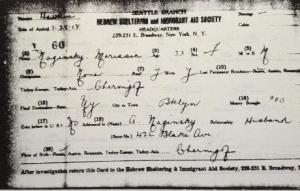
As part of its effort to help newly arrived immigrants reach their destination and get settled in their new country, HIAS prepared registration cards, such as this one for Mariasia Naginsky, to track the progress of their charges.
Where the work of U.S. immigration officials ended, the work of the Hebrew Sheltering and Immigrant Aid Society began. A representative of the organization, perhaps Seattle home manager Abe Spring, would be at the steamer dock to meet arriving ships. His task there would be to identify those passengers “likely to belong to the class that the organization caters to,” as described in written instructions, and to gain their confidence so HIAS could provide assistance to those in need.
HIAS provided a wide range of services to immigrants upon their arrival. Once admitted, the representative would help them with their immediate needs — checking and transfer of baggage, exchange of foreign money, and transportation assistance for those continuing on to another destination. The Society helped guard against unscrupulous agents offering these and other services to those unfamiliar with the language, currency and customs of a foreign country. For those individuals who had to be hospitalized or quarantined, the representative also would offer assistance, with regular visits providing information about their situation, help in writing to their relatives, and reassurance that “no injustice would be done to them by our government.”
Even those who were detained or excluded by the Board of Special Inquiry would receive special attention from HIAS. In many cases, the organization was able to solve problems by finding the address of a relative, providing funding for transportation inland or referring a case to the chairman of the Society’s law committee. When all avenues were exhausted, the branch would provide support to individuals who faced deportation, including those considered “unworthy” because they were found to be immoral, criminal or alien enemies — among the many classes barred entry to the U.S. — offering comfort and sufficient funds to allow them to return to their desired location in their home country.
The Naginskys were among those who benefited directly from the intervention of the Hebrew Sheltering and Immigrant Aid Society. Once admitted, each member of the family would be registered by the Seattle branch of HIAS, as shown in the individual cards of Mariasia, 33; Jhina, 9; Chaya and Mira, 8; Zepora, 6; and Chana, 4. The information on the cards was the same as that on the ship manifest, including the steamer name, date of arrival, final destination, last permanent residence, birthplace and amount of money brought with them. More importantly, the cards provide concrete evidence of the involvement of HIAS in the family’s care.
After being discharged from the custody of immigration authorities, the Naginskys likely were taken by automobile to the shelter house of the Seattle branch of the Hebrew Sheltering and Immigrant Aid Society, about 2 miles from Pier 6. As described in the HIAS representative’s instructions, the immigrants were to be “conducted to that place in a manner and by means that will expose them to the least embarrassment because of their personal appearance after going through the ordeal of the journey and particularly the nervous tension incidental to the landing.”
A number of tasks and opportunities awaited the Naginskys when they arrived at the home in late January 1918. HIAS staff would take advantage of every day the immigrants were under their care to prepare them for life in America while they awaited processing of paperwork and completion of the travel arrangements that would allow them to proceed to their next destination — and, for Mariasia and her daughters, bring them another step closer to reuniting with their husband and father.
Naomi, as always your chapters in the story of Grandma and her daughters journey to America is fascinating, informative and beautifully written. Will the next chapter be about their train trip across the entire United States? I asked my mother once about this trip and she said that as they looked out of the train window they saw vast, unending landscapes. Will you continue once they reach New York and reunite with Aaron? I know that for a while they lived in Elizabeth, NJ. My mother was very unhappy there. She was nine and had been to school in Russia where she was an excellent pupil. In Elizabeth she was put into a class with first graders
Thanks, I’m always glad to hear that you (and any other family members) like what I’ve written. 🙂 Yes, I am working on the train trip across the U.S. via Chicago. I don’t have a lot to go on, so I’m glad you had a little info. Did your mom ever say anything else about the trip? About Chicago? Their reunion with Aaron?
[…] reasoned Great Northern’s Hill, who saw opportunity in greater overall volume. By 1921, published fares for adults traveling from Seattle to Chicago were starting at $9.90 for a “Tourist Upper […]